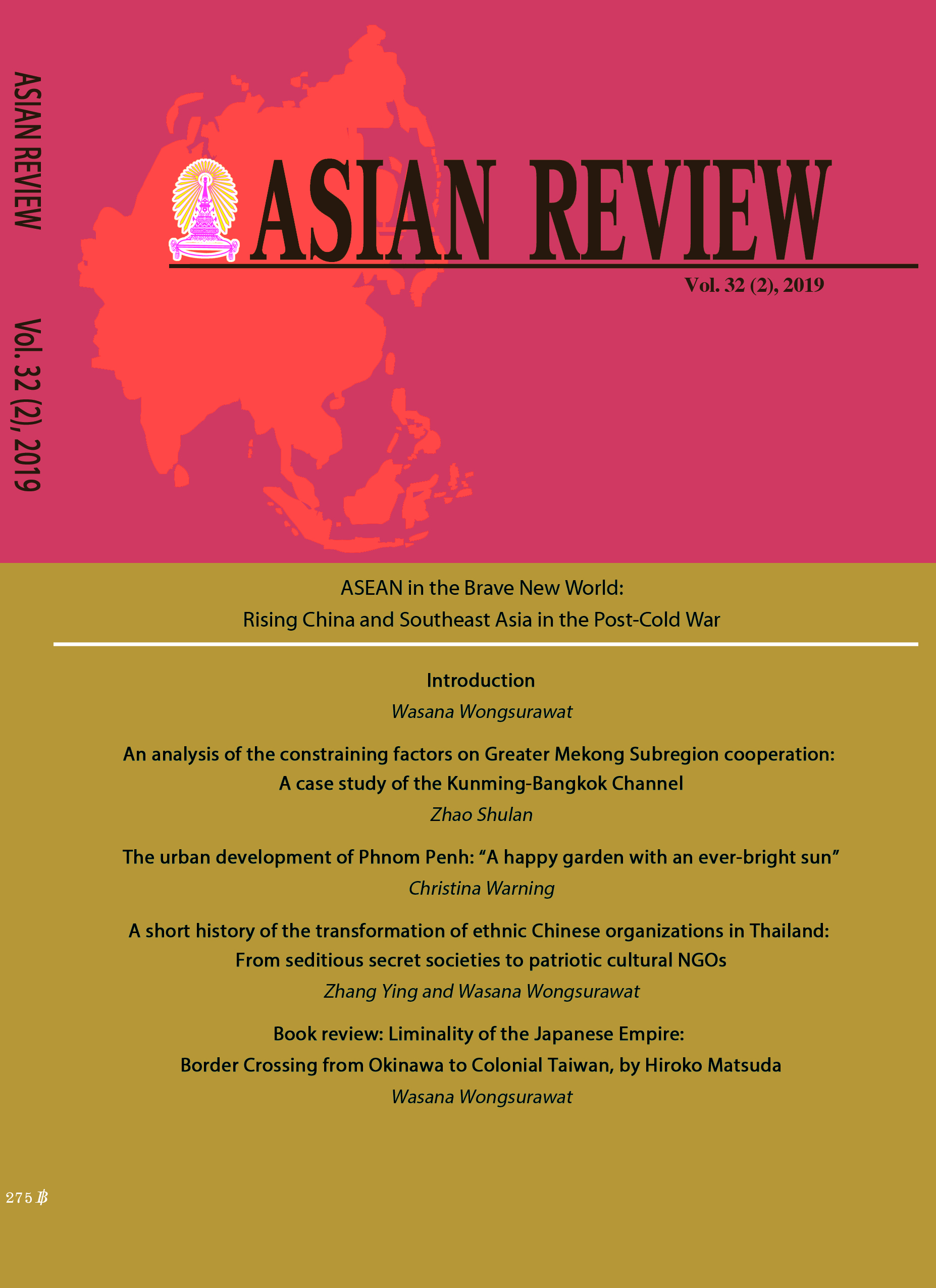A short history of the transformation of ethnic Chinese organizations in Thailand: From seditious secret societies to patriotic cultural NGOs
Keywords:
Ethnic Chinese organizations, NGO, secret society, trade association, philanthropic association, modernization, nationalismAbstract
Ethnic Chinese organizations in Thailand were transformed and developed through the past century and a half of the modern era in three major phases. In the early-19th century, an influx of Chinese labor migrants followed the tradition of establishing fi ctive kinship networks in their host country through sworn
brotherhoods and secret societies. Towards the end of the 19th century, however, the modernization and nation-building processes of the Thai state came into confl ict with the culture and lifestyle of Chinese secret societies and they became criminalized. Consequently, the ethnic Chinese community in Thailand entered the second phase of registering their ethnic organizations as legitimate trade and philanthropic associations according to the Thai law in the early-20th century. These trade and philanthropic associations also played an important political role as representatives and organizers of the ethnic Chinese community through the period leading up to and during the Second World War. After the conclusion of the War, Chinese associations came under serious scrutiny from the Thai
state that had become increasingly paranoid of Chinese communist threats from the People’s Republic of China. Ethnic Chinese organizations in Thailand, thus, transformed into the third phase by registering as NGOs according to the government’s National Economic and Social Development Plans in the 1960s, and proliferated as clan associations from the 1970s onwards. The main purpose of Chinese clan associations from this late Cold War period to the present day
remains largely the same. That is, to encourage networking within each organization, networking among fellow Chinese organizations and to act as a bridge to better the ethnic Chinese community’s relationship with the Thai general public, the Thai government, and the rising infl uence of the People’s Republic of China in the post-Cold War period.
References
Bisalputra, Pimpraphai and Jeffery Sng. 2015. A History of the Thai-Chinese. Singapore: Editions Didier Millet.
Chartsiri, Jirathorn. 2009. “Th e Emergence and Development of the Thonburi Kingdom in the Context of the Chinese Era, 1727-1782.” Ph.D. diss., Chulalongkorn University.
CCGAT (Chen Clan General Association of Thailand) 1993. Special Issue commemorating the 30th Anniversary of the Chen Clan General Association of Thailand, 1963-1993. Bangkok: CCGAT.
Chinwanno, Chulacheeb. 2001. 35 pi khwam samphan thang kan tut thai chin. [35 years of Thai-Chinese diplomatic relations]. Bangkok: Open Books.
Davis, Fei-ling. 1971. Primitive Revolutionaries of China: A Study of Secret Societies in the Late 19th Century. London: Routledge and Kegan Paul.
Hakka Association of Thailand. 2019. The History of the Hakka Association of Thailand. http://www.fristweb.com/user/hakka/index. php?langtype=tw&pageid=tw_26 (last accessed 26 May 2018)
HAT (Hwang Association of Thailnad) 2013. Commemorative Special Issue for the 50th Anniversary of the Hwang Association of Thailand, 1963-2013.
Bangkok: HAT.
Huang Biyun. 2010. “The Role of the Chinese in Thailand: Chinese Society from Rama III to Rama V, 1824-1910.” Ph.D. diss., Shanghai University.
KCAT (Khoo Clan Association of Thailand) 2010. Commemorative Special Issue for the 50th Anniversary of the Khoo Clan Association of Thailand and
2nd Qiu Clan Association World Congress. Bangkok: KCAT.
Kuhn, Philip A. 2008. Chinese Among Others: Emigration in Modern Times. Lanham: Rowman and Littlefield.
Kwong Siew Association of Thailand. 2010. Introduction to the Kwong Siew Association of Thailand. http://www.kwongsiewthai.com (last accessed 21
May 2018)
LCA (Lee Clan Association) 2013. Lee Clan Association (Thailand) 50th Anniversary Celebration, 1963-2013. Bangkok: LCA.
LCAT (Lim Clansmen Association of Thailand) 2012. The Special Issue of the 50th Anniversary of the Establishment of the Lim Clansmen Association of Thailand, 1962-2012. Bangkok: LCAT.
Murashima, Eiji. 1996. Kanmueang chin siam [China-Siam politics]. Bangkok: Institute of Asian Studies, Chulalongkorn University.
Poh Teck Tung Foundation. 2010. Poh Teck Tung Foundation Centennial Commemorative Special Issue. Bangkok: Poh Teck Tung Foundation.
Skinner, G. William. 1957. Th e Overseas Chinese in Thailand: An Analytical History. Ithaca: Cornell University Press.
TAT (Tachasumphan Association of Thailand) 2013. Th e 40th Information Volume of the Tachasumphan Association of Thailand. Bangkok: TAT.
Tejapira, Kasian. 2004. “The emergence of NGO movements in Thailand and the Sarit Regime.” In Shinichi Shigetomi, ed., The NGO Way: Perspectives and Experiences from Thailand. Chiba: Institute of Developing Economies, JETRO.
Teng, Ssu-yu and John K. Fairbank. 1979. China’s Response to the West: A Documentary Survey, 1839-1923. Cambridge: Harvard University Press.
Thai-Chinese Chamber of Commerce. 2015. The History of the Thai-Chinese Chamber of Commerce. https://thaicc.org/2015/aboutthaicc/history.thml
(last accessed 21 March 2019)
Thairath newspaper. 10 March 2015.
Teochew Association of Thailand. 2012. Introduction to the Tio Chew Association of Thailand. http://www.tiochewth.org (last accessed 23 May 2018)
UCCAT (United Chinese Clans Association of Thailand) 2013. The United Chinese Clan Association of Thailand 5th Board of Executive Committee 2013-2015. Bangkok: UCCAT.
Van Roy, Edward. 2017. Siamese Melting Pot: Ethnic Minorities in the Making of Bangkok. Chiang Mai: Silkworm Books.
Wang Gungwu. 2002. The Chinese Overseas: From Earthbound China to the Quest for Autonomy. Cambridge: Harvard University Press.
Wongsurawat, Wasana. 2017. “Rise of the red capitalists: PRC influence and the new challenge of the Royalist-Chinese business alliance in Thailand.”
In Yos Santasombat, ed., Chinese Capitalism in Southeast Asia: Cultures and Practices. Singapore: Palgrave Macmillan.
Wongsurawat, Wasana. 2019. The Crown and the Capitalists: The Ethnic Chinese and the Founding of the Thai Nation. Seattle: University of Washington Press.
XCAT (Xu Clan Association of Th ailand) 2014. 50th Anniversary Commemorative Special Issue of the Xu Clan Association of Th ailand. Bangkok: XCAT.
Downloads
Published
How to Cite
Issue
Section
License
Published articles are under the copyright of the Instiute of Asian Studies, Chulalongkorn University. Partially or totally publication of an article elsewhere is possible only after the consent from the editors.







